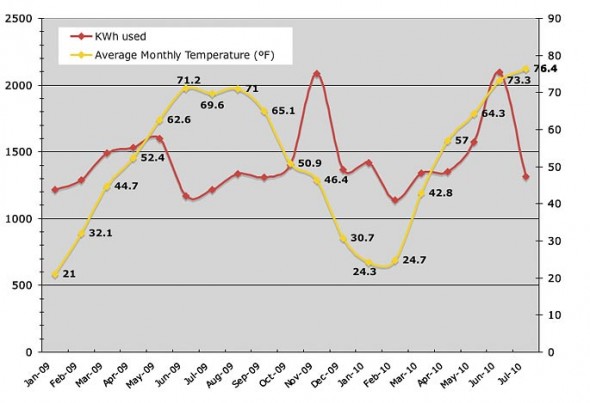Yellow Springs monthly residential electrical consumption
- Published: August 5, 2010
Villager Chris Roberts first suggested that the News provide an energy counter for the village last year. We liked the idea of helping residents to gauge the progress that’s being made toward the energy conservation that Village Council members were aiming toward when they created an energy board this summer to lead the effort.
This is the first in a monthly report on the residential use of electric power within the village limits. The chart below shows the average residential Kilowatt/Hours (KWh) used in Yellow Springs, against the average monthly temperature. The RED line tracks the actual average monthly electrical usage for 2009 and part of 2010, based on 1,200 single residences, and about 50 apartment units. The YELLOW charts the average monthly temperature.
In future posts, Matt and Megan will provide figures that are normalized for the weather variable, so that the data reflect consumption regardless of abnormally hot days in the summer or abnormally cold days in the winter. Look for the August figures on the Web site next month.
Yellow Springs Residential KWh versus Average Monthly Temperature
2 Responses to “Yellow Springs monthly residential electrical consumption”
The Yellow Springs News encourages respectful discussion of this article.
You must login to post a comment.
Don't have a login? Register for a free YSNews.com account.















Hi Randy!
Good point. We worked on this quite a bit at the News. It was very confusing to us at first glance, too, but we realized that actual temperature was only ONE variable. The other, far more influential one, is the heat index, or perceived temperature. So if there’s an 80-degree day and 15% humidity, people are going to use a lot less power to cool off than during one of those horrid 78-degree, 86% humidity days.
Because of this confounding factor, we initially planned to chart temperature against KWh per degree. Then we were going to chart the Cooling Degree Days, or CDD*, but it all ended up being too difficult to fit into a nutshell explanation. So we opted for charting the most straight-forward data — temperature vs. KWh — and decided to wait for the inevitable questions. (*CDD – number reflecting the demand for energy required to cool a building to an arbitrary comfort temperarture, usually 65DegF; opposite is Heating Degree Days, or HDD),
Also, in explaining the trends observed in the data, we were made aware of the fact that, while heating consumes various energy sources, cooling is pretty much exclusively electric. This explained the high electrical use during a humid summer, even though the temperature differential to cool to a comfortable level in the summer is less than to heat to a comfortable level in the winter. And as for the December peak, our UD collaborators on this project suggest it may be due to increased residential and holiday lighting, cooking and socializing.
Finally — yes, the billing data may be off by a month. We hope to clarify this by charting older data. THANKS for your thoughtful comment! —Matt
(take 2)
I’m a bit confused about the YS power use graph.
One would expect power consumption to generally trend WITH the average temperature in the summer months, and INVERSE to the temperature trend in the winter months. Summer and winter are (almost) always the peak power seasons due to increased cooling and heating load. What we see in the pictured graph is the inverse of that, with peak consumption seemingly occurring in the “shoulder” months of spring and fall, traditionally times of negligible heating and cooling load.
The cycle seems to be consistent as we see the power use trend line dipping steadily as it headed into July ‘10. In reality, especially during this very warm summer, residential power consumption should be trending generally with the average summer temperature trend.
I’m not a YS resident so there may be a plausible explanation for this anomoly that I am not aware of: offset billing cycles, supplemental community power programs, or some other reason. It may simply be that the two trends are not chronologically in sync. I’d be interested to know if there are programs or unique use patterns common in YS.
It is interesting that a small community would care enough to want to trend average residential power consumption. I’ve spent most of my professional career in the power generation biz, and it’s refreshing to see that some people actually think about electricity other than (1) when they receive their bill, and (2) when there’s an outage. Kudos to YS for caring.